With Beijing Old Liu ...
[video v=XG3UQFykK2g] Plus more videos ...
Live more ...
With Beijing Old Liu ...
[video v=XG3UQFykK2g] Plus more videos ...
With CGTN / Travelogue ...
[video v=t8DUZNDS_cQ start=30]The eight surrounding temples - with Beijing Old Liu ...
Plus more videos ...
With Lulu's Daily In China ...
[video v=vN7wputbiOI]The Humble Administrator's Garden, located in SuZhou, JiangSu province, is one of the most famous classical gardens in China. Built in the early 16th century during the Ming Dynasty, this garden is a masterpiece of Chinese landscape design, featuring beautiful pavilions, serene ponds, lush greenery, and exquisite rock formations. It is a UNESCO World Heritage Site and a must-visit destination for anyone interested in traditional Chinese garden art.
The garden was originally created by Wang XianChen, a retired government official, who sought to design a peaceful retreat for himself. Over the centuries, the garden changed hands multiple times, undergoing various renovations and expansions. Despite these changes, the garden has retained its original layout and classical elements, reflecting the aesthetics and philosophical principles of traditional Chinese gardens.
The Central Garden is the heart of the Humble Administrator's Garden, featuring a large pond surrounded by lush plants, winding paths, and elegant pavilions. Key highlights include:
The Eastern Garden features a series of smaller ponds, rockeries, and pavilions, creating a more intimate and secluded atmosphere. Notable features include:
The Western Garden is characterized by its open spaces and carefully arranged rockeries and plantings. Highlights include:
The Humble Administrator's Garden exemplifies the principles of traditional Chinese garden design, which seeks to create harmony between nature and human-made structures. The garden's architecture and layout incorporate the following elements:
"ShuHe Ancient Town, known as "ShaoWu" in NaXi language, was formed by the JuBao Mountain behind the village, which is shaped like a pile of peaks. It is also an important well-preserved market town on the Ancient Tea-Horse Road, a living specimen of the NaXi ancestors’ transition from farming civilization to commercial civilization, and a model of market town construction formed by opening up to the outside world and caravan activities. ShuHe Ancient Town, BaiSha Ancient Town and DaYan Ancient Town together form the World Heritage Site of LiJiang Ancient Town.
Xu XiaKe once passed by ShuHe River when he visited JieTuo Forest in ZhiShan. "Ten Harmonies" is the ancient name of today's ShuHe."
With Bob's Street Snapshots ...
[video v=v9ZWCJ-JojQ]GanSu's UNESCO World Heritage Site ...
[video v=-NUkxiZmYx0]JiangSu province.
Harmony of human and nature; diverse landscapes in a small space; a new vista at every turn.
With Walk East ...
[video v=uDkJb-T7b8Y]Follow this traveler's videos of places walked and adored.
Discover some of China's incredibly diverse natural landscapes.
Including JiuZhaiGou, the YuLong River, the ShiLin Stone Forest, DunHuang desert and oasis, Tiger Leaping Gorge and ZhangJiaJie.
Chinese culture is founded on the harmony of people and nature and the reverence of natural beauty ...
[video v=m9BhKD44B_o]Plus, the beautiful Flight of the Dragon ...
Plus more videos ...
DānXiá Shān is a world famous UNESCO World Heritage Site Geo-Park.
The area comprises a reddish sandstone which has been eroded over the years into a series of outcrops with spectacular cliffs and unusual rock formations.
There are a number of temples in the mountains and many scenic paths. FuYiJiang River winds through the mountains and boat trips are possible.
[video v=Fywr9peHX_8]Tiger Leaping Gorge in YunNan province lies 60 kilometers north of LiJiang and is part of the UNESCO 'Three Parallel Rivers of Yunnan' World Heritage Site.
The gorge in gorgeous 4K by Milosh Kitchovitch ...
[video v=t7E4oBmG6rc]Hiking with Tim and Glo ...
Plus more videos ...
A trip to the sacred HuangShan Mountain 黃山, AnHui province
HuangShan is well known for its beautiful scenery, sunsets and sunrises, unusually shaped granite peaks, ancient pine trees, hot springs, winter snow, and views of the clouds from above. Some of the peaks rise more than 1,800 meters (6,000 feet). HuangShan is a frequent subject in traditional Chinese paintings and literature. HuangShan is a UNESCO World Heritage Site, and one of China's most popular tourist destinations. The HuangShan area is also noted for Chinese teas of high quality. In the first film, a group of photographers spend a week on the Yellow Mountain and show that patience and dedication pays off ...
The beautiful YuanYang 元阳 rice terraces, south YunNan province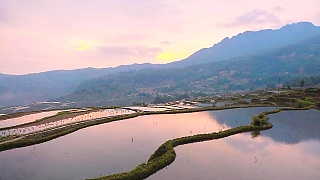
HóngCūn is a well preserved 800 year old village in southern AnHui province, near the southwest slope of Mount HuangShan. Award-winning Virtual Reality film ... A trip to HongCun ...
Beautiful Mount EMei (EMeiShan 峨眉山) from the air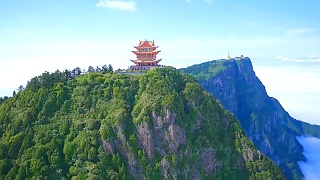
The first Buddhist temple in China was constructed here in SiChuan province in the 1st century A.D. The addition of other temples has turned Éméi Shān into one of Buddhism's holiest sites and is one of the four sacred Buddhist mountains of China. All in all, there are now seventy six Buddhist temples and monasteries, most of them located near the mountain top. The first two films focus on the most well-known - the Golden Summit and the 48 meters tall statue of Samantabhadra, known in Mandarin as PǔXián PúSà 普賢菩薩.
The beautiful WuYi Mountains 武夷山
WuYiShan lies in FuJian province and is a UNESCO World Heritage Site.
Beautiful HuangLong 黃龍 Scenic Area, SiChuan province
HuangLong ('Yellow Dragon' - the appearance of the pools along HuangLong Valley) lies 150 kilometers (93 miles) north-northwest of the provincial capital ChengDu. All in all, it covers an area of almost 2,000 square kilometers. This area is known for its colorful pools formed by calcite deposits, as well as diverse forest eco-systems, snow-capped mountain peaks, waterfalls and hot springs. There are also a number of temples. HuangLong is also home to the Giant Panda.
The temples and natural landscape around Mount EMei 峨嵋山 and LeShan Giant Buddha 乐山大佛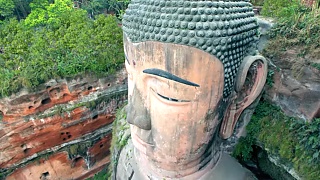
A beautiful film of the scenic area around ÉMéiShān and LèShān Dàfó, SìChuān province. Mount EMei is one of the Four Sacred Buddhist Mountains of China on which there are nearly 70 Buddhist monasteries. At 71 meters (233 feet) in height, LeShan Giant Buddha is the largest stone Buddha in the world.
The magnificent Tiger Leaping Gorge 虎跳峡, YunNan province, in Ultra HD / 4K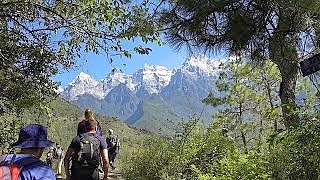
Filmed during two days hiking in the Tiger Leaping Gorge. At a maximum depth of approximately 3790 meters, from the YangTze River to mountain peak, Tiger Leaping Gorge is one of the deepest and most spectacular river canyons in the world. Tiger Leaping Gorge lies between Jade Dragon Snow Mountain and HaBa Snow Mountain. It is part of the Three Parallel Rivers of Yunnan Protected Areas UNESCO World Heritage Site.
JiuZhaiGou 九寨沟 : Autumn into Winter (Ultra HD / 4K)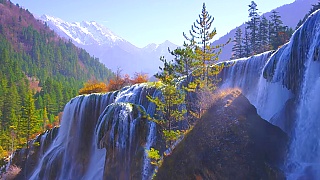
'Nine Villages Valley', SiChuan province. Aqua pools, streams and waterfalls, and snow capped peaks, surrounded by red and gold leaves - a very beautiful place ...
LeShan Giant Buddha 乐山大佛, Mount Emei 峨眉山 Scenic Area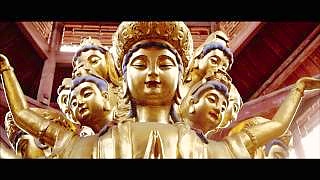
The LeShan Giant Buddha 乐山大佛 is located in SiChuan province and is a 233 foot tall stone statue constructed during the Tang Dynasty. Emei Shan (3,100 meters / 10,200 feet) is one of the four Chinese Buddhist sacred mountains. Emei Shan is UNESCO World Heritage Site (together with the Leshan Giant Buddha) : "...an area of exceptional cultural significance as it is the place where Buddhism first became established on Chinese territory... The first Buddhist temple in China was built on the summit of Mount Emei in the 1st century CE." Documentaries ...
West Lake 西湖 boat trip, HangZhou 杭州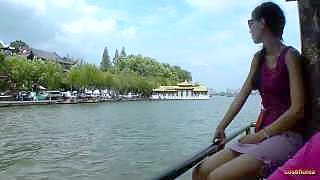
ZheJiang province. Xī Hú is a fresh water lake with the city on side. There are numerous temples, pagodas, gardens, bridges and artificial islands within and around the lake. West Lake is a UNESCO World Heritage Site as an outstanding example of Chinese garden arts and the guiding principle of harmony between human and nature.
Hiking trip to the 'Big Peak' (5025m), Mount SiGuNiang 四姑娘山
Mount SiGuNiang, in SiChuan province, is famous for its beautiful scenery. The surrounding area is reputed to be the "Oriental Alps". Mount SiGuNiang National Park is a UNESCO World Heritage Site. The park comprises Mount SiGuNiang and the surrounding three valleys, namely ChangPing Valley (长坪沟), HaiZi Valley (海子沟) and ShuangQiao Valley (双桥沟), covering an area of 2,000 square kilometers. Mount Siguniang
LeShan Giant Buddha 乐山大佛 scenic area, SiChuan province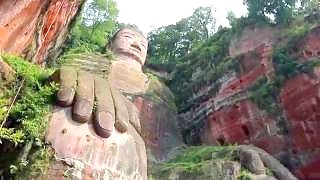
The Giant Buddha, which is around 70 meters in height, was carved out from the hill during the Tang dynasty (618–907). It took 90 years to complete. The LeShan Giant Buddha is part of the Mount Emei Scenic Area, which is a UNESCO World Heritage Site. This area has exceptionally diverse vegetation, ranging from subtropical to sub-alpine pine forests. Over time, additional temples established nearby making this an important place in Buddhism. There is a lot to see and explore. Slideshow (with some great photos) :
The caves, full of beautiful Buddhist art, are located near DaTong in ShanXi province, north east China (west from Beijing), and date from the 5th century. Buddhism came to this area via the northern Silk Road that linked Xi'An with Kashgar
HongCun 宏村 Village, AnHui province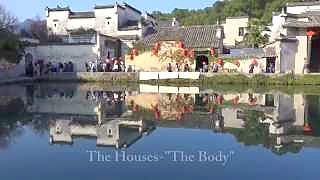
Step back in time in the ancient village of HongCun, 宏村. HongCun is located near the south west slope of Mount HuangShan. The architecture and carvings of the approximately 150 residences dating back from the Ming and Qing dynasties are said to be among the best in China. One of the largest residences open to visitors, ChenZhi Hall, also contains a small museum. Together with XiDi, the village is a UNESCO World Heritage Site. Some scenes from the movie 'Crouching Tiger, Hidden Dragon' were filmed on location in HongCun.
Mount HuangShan 黄山 : a documentary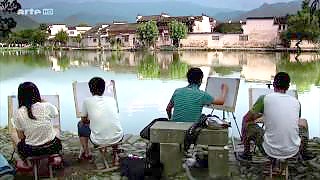
HuangShan (Yellow Mountain) is a group of mountains in AnHui province, east China. Famous for its rugged peaks, unusual rocks and tenacious pine trees, this beautiful landscape is a UNESCO World Heritage Site.
The wonderful, beautiful HuangShan 黄山
Yellow Mountain, 黄山, in AnHui province, between ShangHai and WuHan, is one of China's most popular travel destinations. An area of outstanding natural beauty, it is a UNESCO World Heritage Site.
SanQing Shan 三清山 National Park
SanQing Shan, 三清山, is a renowned Taoist sacred site located 25 miles (40 km) north of YuShan County in JiangXi Province. With outstanding natural scenery, plants and wildlife, the park is a UNESCO World Heritage Site that in all covers 230 square kilometers. SanQing means the "Three Pure Ones" in Chinese as Mount SanQing is composed of three main summits: YuJing, YuShui, and YuHua, representing the Taoist trinity. YuJing (rising 1820 meters above sea level) is the highest. 三峰峻拔、如三清列坐其巅
The Spirit Way, Ming Tombs 明十三陵, BeiJing
The Ming Tombs are a collection of mausoleums built by emperors of the Ming dynasty. They lie within the ChangPing District of BeiJing Municipality, 40 kilometers (25 miles) north-northwest of Beijing city center. The site was chosen based on the principles of Feng Shui by the third Ming emperor, YongLe. Construction began after completion of the Imperial Palace (Forbidden City) in 1420. Subsequent emperors placed their tombs in the same valley; 13 in total. The siting of the Ming dynasty imperial tombs was carefully chosen according to Feng Shui principles. A key guide is that bad spirits and cold winds from the north must be deflected; therefore, an arc-shaped valley area at the foot of the JunDu Mountains was selected. This 40 square kilometer area, enclosed by mountains in a pristine, quiet valley with dark earth and tranquil water became the necropolis of the Ming dynasty. A 7 kilometer (4 mile) path named the Spirit Way, or Sacred Way, leads into the complex, lined with statues of guardian animals and officials, with a front memorial gate consisting of three arches called the Great Red Gate; constructed in 1540, it is one of the biggest stone archways in China. Further in, lies the ShenGong ShengDe Stele Pavilion with a 50 tonne stone statue of BiXi carrying a memorial tablet. Four white marble HuaBiao (pillars of glory) are positioned at each corner of the pavilion; at the top of each is a mythical beast. Then come two pillars on each side of the path, whose surfaces are carved with a cloud design, and tops are shaped like a cylinder; these are of a traditional design and were originally beacons to guide the soul of the deceased, The path leads to 18 pairs of stone statues of mythical animals, which are all sculpted from single blocks; these are all larger than life size. After, the path leads to a three-arched gate known as the Dragon and Phoenix Gate. Two of the mausoleums are open to visitors, but it is the beauty of the valley, with orchards, and the sheer scale of the area used for the tombs, that make this a nice day out in the countryside.
This is LiJiang 丽江 old town ...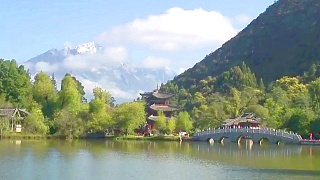
The ancient town of LiJiang, in YunNan province, is a UNESCO World Heritage Site, with over 800 years of history. It was an important hub of the South Silk Road, along which many items were traded, including tea. It is home to the NaXi ethnic minority. LiJiang has lots of boutique hotels and cosy hostels in traditional architecture. The town, with its cobbled streets, streams and bridges, features many crafts (embroidery, silverware, drums and more) plus a wide variety of street snacks and restaurants.
Scenes from ChengDe 承德 - video
Surrounded by mountains on three sides, ChengDe in HeBei province, about 3 hours north east of Beijing, was a summer retreat for Ming emperor KangXi and also assocaited with emperors YongZheng and QianLong. Now a UNESCO World Heritage site, it features numerous scenic spots and is a great long weekend break. It is centered on the largest imperial park in China, with a surrounding wall of over 10km, which is a great hike. Within lie lakes and pagodas; beyond are eight temples in various architectural styles.
A trip to the beautiful HuangShan 黄山 mountain - video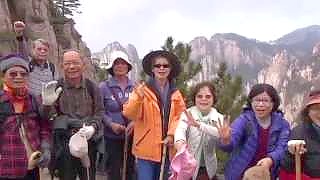
HuangShan (Yellow Mountain) is one of the most famous scenic areas in China and a UNESCO World Heritage Site ...
LuShan 庐山 National Park, JiangXi province
The park lies to the west of China's largest freshwater lake, PoYang Lake. The national park covers an area of around 500 square kilometers (about 320 square miles) with more than 90 mountain peaks. The tallest, HanYang Peak, soars to a height of 1475 meters (4,850 feet). LuShan National Park owes its reputation to its varied and spectacular features that embraces ravines, waterfalls, grottoes, rocks and streams. There are 12 main scenic areas, including 37 attractions.
A trip to West Lake 西湖, HangZhou
West Lake (Xi Hu) is a famous fresh water lake located in the center of HangZhou, provincial capital of ZheJiang in east China. The lake is divided by a number of causeways and there are numerous temples, pagodas and other scenic spots dotted around. West Lake has influenced poets and painters in China, Korea and Japan throughout centuries for its beauty, historical relics and garden/landscape design, with its harmony of human construction and nature. West Lake was desclared a UNESCO World Heritage Site in 2011.
Mount EMei 峨眉山 scenic area, including the LeShan giant Buddha 乐山大佛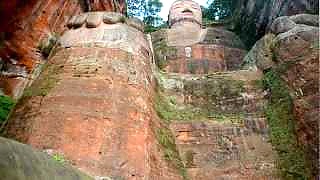
A UNESCO World Heritage site. The first Buddhist temple in China was built here in SiChuan province during the 1st century A.D. in the beautiful surroundings of the Mount Emei and in view of its peak. Over the centuries, the addition of other temples turned the area into one of Buddhism's holiest. The most remarkable - the Giant Buddha at LeShan - was carved out of a hillside in the 8th century and looks down on the confluence of three rivers. At 71 meters in height, it is the largest Buddha in the world.
The beautiful capital of ZheJiang province. HangZhou was the capital of the Southern Song Dynasty and remained so until the Mongol invasion of 1276 (the start of the Yuan dynasty). The West Lake is a famous fresh water lake located in the historic center of HangZhou. It was listed as a UNESCO World Heritage Site in 2011.
The Putuo ZongCheng Temple 普陀宗乘之庙 in ChengDe 成德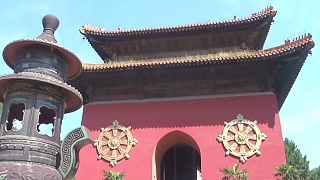
The Putuo ZongCheng Temple in ChengDe, HeBei province, is a Qing dynasty Buddhist temple. The complex was constructed between 1767 and 1771 during the reign of emperor QianLong (1735–1796). It is located just north of the ChengDe Mountain Resort. Along with the equally famed Puning Temple, it is one of the Eight Outer Temples of ChengDe (a UNESCO World Heritage Site). The temple was modeled after the Potala Palace in Tibet. The temple complex covers a surface area of some 220,000 square meters, making it one of the largest in China. The Mountain Resort in ChengDe 避暑山庄 (BìShǔ ShānZhuāng literally means "Mountain Villa for Avoiding the Heat") was an imperial get-away. Built between 1703 and 1792 during the Qing dynasty, the vast Mountain Resort covers a total area of 5.6 square kilometers (2.2 square miles) and is surrounded by a mini 'Great Wall', which one can walk. It contains a variety of gardens, pagodas, temples and palaces representing the styles from various regions of China.
Mount Tai 泰山 in ShanDong province
Mount Tai is one of China's Five Sacred Mountains and has been a place of worship for at least 3,000 years. Mount Tai (or TaiShan, though there is a city called TaiShan in GuangDong - a different place) is a mountain of both historical and cultural significance which is located north of the city of Tai'An in ShanDong province. The tallest peak is the Jade Emperor Peak which reaches a height of 1,533 meters (just over 5,000 ft). In total, there are 22 temples, 100 ruins, 820 stone tablets, and over 1,000 cliff-face and rock inscriptions, including the Wordless Stela that stands in front of the Jade Emperor Temple. Legend tells that the emperor who commissioned the stela was dissatisfied with the planned inscription and decided to leave it blank. It is a UNESCO World Heritage Site.
The Forbidden City 紫禁城 in BeiJing
A documentary by CCTV. A UNESCO World Heritage Site.
A water town in north-east JiangSu province, not far from Shanghai. SuZhou Old Town is famous for its gardens as well as canals. The classical gardens are on the UNESCO World Heritage Site list.
The beautiful HuangLong 黄龍 Scenic Area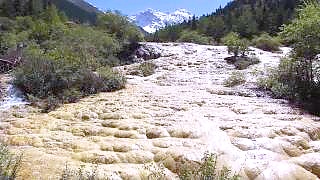
A UNESCO World Heritage Site. HuangLong Scenic Area lies in SiChuan province, about 150km north west from the provincial capital ChengDu. It is famed for its colorful pools formed by mineral deposits, and there are also rich forests full of wildlife, including the Giant Panda, snow-capped peaks, waterfalls and hot springs.
The wonderful waterfalls of JiuZhaiGou 九寨沟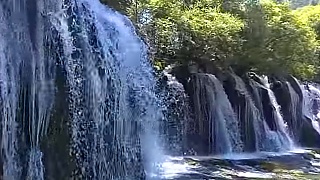
A scenic area / nature reserve in SiChuan province. Also, a UNESCO World Heritage Site.
The Three Natural Bridges 天生三桥 of WuLong County, ChongQing
A great day out in splendid scenery ... Part of the movie Curse of the Golden Flower was filmed here. The scenic area is about two and a half hours from the city of ChongQing by bus and is a UNESCO World Heritage Site.
PingYao 平遥, ShanXi Province - video
With CCTV's Travelogue The ancient city wall and Ming and Qing architecture in the old part of the city of PingYao are a UNESCO World Heritage Site. PingYao lies about 700 kilometers south west of Beijing and 80 kilometers from TaiYuan, the provincial capital.
The Summer Palace 頤和園, BeiJing - video
The Summer Palace is the largest and best-preserved imperial garden in China. As its name suggests, the Summer Palace was used as a summer residence by China's imperial rulers - as a retreat from the main imperial palace now known as the Palace Museum (or 'Forbidden City') - a pleasure-ground in the countryside, yet near to the city. In 1860, as part of the 'Opium Wars', the Anglo-French Allied Forces invaded Beijing and set fire to many of the buildings within the original Summer Palace (YuanMingYuan). In 1888, Dowager Empress CiXi, with funds embezzled from the Imperial Navy, restored the grand gardens. The reconstruction and enlargement of the Summer Palace continued for ten years. After completion, she renamed the gardens 'YiHeYuan' ('Garden of Peace and Harmony'). The Empress Dowager CiXi moved her administration to the renovated YiHeYuan in 1889 and the gardens here that had long been an imperial pleasure-ground became the primary Summer Palace. Then, shortly after, the eight allied powers invaded in 1900 during the Boxer Rebellion to plunder and destroy the newly reconstructed New Summer Palace. Only when the fugitive CiXi returned to Beijing in 1903, did full-scale restoration begin. In this way, the Summer Palaces - both old and new - are associated in popular culture with the destructive interference of foreign powers. Today's Summer Palace is more or less the same as the palace rebuilt from 1903. It was designated a World Heritage site by UNESCO in 1990. After the success of the 1911 Revolution, the Summer Palace was opened to the public. Then, after the last Qing Emperor PuYi was thrown out of the Palaces in 1924, the Summer Palace was turned into a park. The Summer Palace has become a popular and relaxing destination for both domestic and international tourists. The Summer Palace is virtually a museum of traditional Chinese gardening that uses rocks, plants, pavilions, ponds, cobble paths and other garden styles to create a poetic effect between different scenes. The halls, pavilions, bridges and temples, Kunming Lake and Longevity Hill, all blend together harmoniously despite their individual styles. Ingeniously conceived and elaborately designed, the Summer Palace, featuring the garden styles of both northern and southern China, is justifiably known as the 'Garden of Gardens'. Indeed, the Summer Palace represents a quintessentially Chinese ideal of harmony between man and nature. Don't miss : the beautiful Garden of Harmonious Interests (a 'garden within a garden'), SuZhou Street and the Four Great Regions Tibetan-style temple, and the Tower of Buddhist Incense and Cloud Dispelling Hall on the hill. The nearest subway station is BeiGongMen ('North Palace Gate') on line 4.
The Temple of Heaven 天坛, Beijing (2)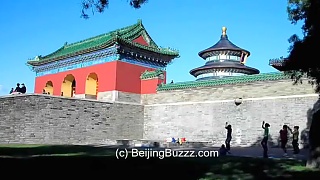
The magnificent Temple of Heaven (TianTan) was constructed between 1406 and 1420 (Ming dynasty) during the reign of the emperor YongLe who also oversaw the construction of the Forbidden City.The Temple of Heaven was where emperors of the Ming and Qing dynasties would offer sacrifices to heaven and pray for good harvests. The temple complex was extended during the reign of emperor JiaJing during the 16th century (Ming dynasty). JiaJing also constructed three other key temples in Beijing : the Temple of the Sun in the east, the Temple of the Moon in the west, and the Temple of Earth in the north. Emperor QianLong directed a renovation of the Temple of Heaven during the 18th century (Qing dynasty). The architecture and layout of the Temple of Heaven is based on elaborate symbolism and numerology. One example is that the buildings and their settings reflect ancient Chinese religious beliefs that imagine heaven as round and earth as square. Because the Temple of Heaven was to be the place representing Heaven on Earth, it needed to be larger than the Forbidden City; it covers approximately twice the area and is about 2 kilometers from north to south, the primary axis with three main structures; indeed, it is the largest group of constructions for worship in the world. In 1998, the Temple of Heaven was added to the UNESCO World Heritage List. In early 2005, the Temple of Heaven underwent a 47 million yuan (6 million USD) renovation that was completed on May 1st, 2006. The Temple of Heaven is a delightful place to spend some time. Arrive in the early morning to watch the Tai Chi experts, although the park is lively all day and into the evening with kite flyers, musicians, singers, dancers and games players (from badminton to Chinese chess).
Jade Dragon Snow Mountain 玉龙雪山 and LiJiang 丽江, YunNan province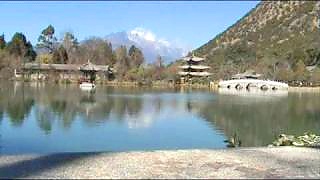
Filmed in February 2010. The peak of the mountain range is 5,600 meters. The view of the mountains from the gardens at the Black Dragon Pool (HeiLong Tan) in LiJiang is regarded as one of China's finest. On the far side of the mountains lies Tiger Leaping Gorge (HuTiao Xia). LiJiang is a city with nearly 1.5 million inhabitants, yet LiJiang Old Town has the architecture and atmosphere of times past; indeed, it is a UNESCO World Heritage site. The Old Town, with its waterways and ornamental bridges, dates back over 800 years.
JiuZhaiGou 九寨沟 Nature Reserve, SiChuan province (slideshow)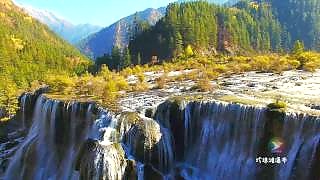
'Nine Villages Valley' (Tibetan and Qiang). With walkways though hills and streams, cyan limestone pools and many waterfalls ...
Charming LiJiang, YunNan province - video
A UNESCO World Heritage Site. LiJiang old town is one of the best preserved in China and is home to the Naxi minority. Nearby attractions include the Jade Dragon Snow Mountain and Lugu Lake.
A trip to Emei Shan, Sichuan province - video
At 3,100 meters (10,170 ft), Mount Emei is the highest of the four sacred Buddhist mountains in China. A UNESCO World Heritage Site. In fact, there are over 70 monasteries here. At the top is Wan-Nian. Emei Shan National Park is 150 kilometers south of ChengDu and 28 kilometers from LeShan. At least one whole day is required. Accommodation is available in some of the monasteries and some people like to view the sunrise from the peak. Tip: buy a mountain map and explore the interesting places off the main trail. Warm and rain-proof attire and good shoes/boots is recommended as the mountain is often bathed in cloud on the way up and the peak can be very cold. Part 1 (the ascent) : Part 2 (the monastry at the top of the mountain) :